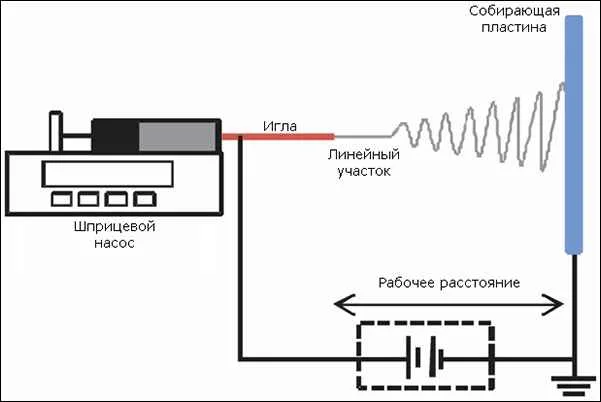 Found technological method of producing nanofibers.
Found technological method of producing nanofibers.
Engineers from the University of North Carolina have modified a known method of manufacture of nanofibers, significantly increasing the speed of their output.
The process of forming fibers with a diameter of ~100-1 000 nm of polymer solutions is called elektrodrazenie. In the design of a typical setup for “spinning” stand out a pump that provides a continuous flow of liquid to a conducting needle, collecting plate and the high voltage source, generating a field between the needle tip and the plate. The solution is in contact with a metal needle, charged, and put into it the charges are accelerated by the electric field and involve in the movement of the surrounding substance, whereby the fluid is accelerated uniformly in the sky, in a thin stream. In the interelectrode gap, the solvent partially evaporates, and the stream turns into fiber, which is deposited on the plate and creates a porous layer.

Diagram of a typical setup for electrospinning. In the experiments of Americans working distance was 15 cm and the applied voltage equal to 11 kV. (Here and below illustration of the journal Nanotechnology.)
Obtained in this way nanostructured fibrous materials are ideal for grasping and removal of solid particles from liquids and gases. If elektrodrazenie to spend a biocompatible and biodegradable polymers, it is possible to create an analogue of the extracellular matrix, which finds application in tissue engineering. Well-known and promising projects and the use of nanofibers in devices of energy accumulation.
Described above is economical, convenient and reliable method of electrospinning adapted for laboratory studies. Industrial production of nanofibers based on it will not build, as it gives a small amount of generation (~0.01–0.1 g/h).
The authors tried to change the mounting design so that its performance is as high as possible. With this aim the needle with the pump replaced conventional aluminum Cup with a diameter of 9 in and a depth of 0.9 cm with a thin 0.3 mm walls, which was filled with the prepared polymer solution. Place collecting plates took a hollow aluminum cylinder with a diameter 39 and height of 37 cm

In the top row of this diagram is an advanced installation (side view in the sectional view and top view). In the bottom row to the left is the 37 jets, simultaneously producing nanofibers from polyethylene oxide and to the right is a graph of voltage variations.
The main series of experiments was carried out using a solution of polyethylene oxide in deionized water. As it turned out, when short-term supply of high voltage (55 kV) from the source to the edge of the Cup spontaneously formed a number of jets, almost evenly distributed on its circumference. After about 20 seconds, the experimenter lowered to the working voltage (16 kV), and the formation of the new jets had stopped, and appeared earlier remained quasistatically; after this, the actual elektrodrazenie.
It is easy to see that increased to a few tens the number of sites electrospinning, while existing on the edge of the Cup, dramatically increases the production of nanofibers. According to calculations, two versions of installation are different from each other in performance to ~40 times at comparable quality and diameter of nanofibers. Similar results were obtained by experiments with a solution of polycaprolactone in dichloromethane and dimethylformamide.
In the near future, engineers plan to complicate the installation — add a device to maintain a given level of polymer fluid in the Cup. This modification and further optimization of operating parameters have yet to increase performance.
Comparison of nanofibers from polyethylene oxide (top row) and polycaprolactone obtained in the normal (left column) and an advanced installation. It is obvious that the modification of the method do not affect the quality of the fibers.

